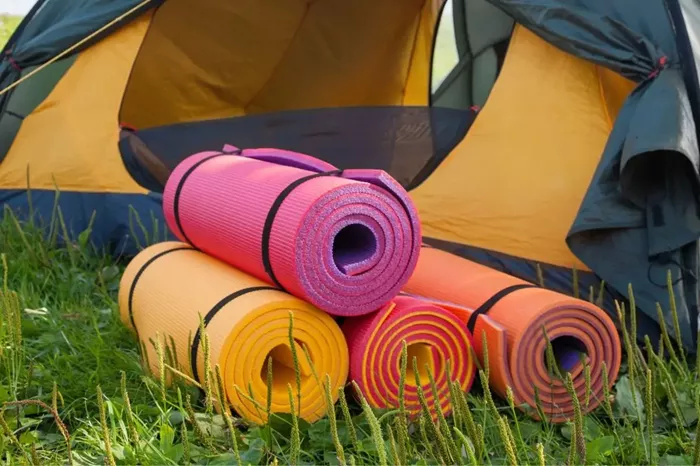A sleeping pad is an essential piece of gear for campers, hikers, and outdoor enthusiasts. It provides cushioning and insulation between your body and the ground. Without a sleeping pad, you would lose body heat quickly and feel uncomfortable on hard or uneven surfaces.
Sleeping pads come in different types, sizes, and materials. They serve two main purposes:
- Comfort: Softens the ground for better sleep
- Insulation: Keeps you warm by reducing heat loss
Why You Need a Sleeping Pad
Many beginners think a sleeping bag is enough for camping. But that’s not true. Here’s why a sleeping pad matters:
- Ground is cold: Even in summer, the ground absorbs body heat. A pad acts as a barrier.
- Rocks and roots hurt: No one sleeps well lying directly on rough terrain.
- Sleep quality affects energy: Good rest means better hiking next day.
- Prevents moisture: Lifts you slightly above damp surfaces.
Types of Sleeping Pads
Air Pads
These are inflatable mats you blow up manually or with a pump. They offer excellent comfort and pack small.
Pros:
- Lightweight
- Compact when deflated
- Adjustable firmness
Cons:
- Can puncture
- Takes time to inflate
- More expensive
Self-Inflating Pads
These combine foam with air chambers. They inflate partially by themselves when unrolled.
Pros:
- Good balance of comfort and insulation
- Easier to inflate than air pads
- Durable
Cons:
- Heavier than air pads
- Bulkier when packed
- May need some manual inflation
Closed-Cell Foam Pads
Made from dense foam with trapped air bubbles. These are the simplest type.
Pros:
- Never deflate
- Inexpensive
- Lightweight
Cons:
- Less comfortable
- Bulky to carry
- No adjustment possible
Key Features to Consider
R-Value
This measures insulation ability. Higher numbers mean warmer pads:
- Summer: R-1 to R-2
- Three-season: R-3 to R-4
- Winter: R-5 and above
Thickness
Thicker pads (2+ inches) are more comfortable but heavier. Thinner pads save weight but feel harder.
Size and Weight
Backpackers prefer lighter, smaller pads. Car campers can choose larger, heavier options.
Material
Common materials include:
- Nylon: Light and durable
- Polyester: More abrasion resistant
- TPU: Flexible and quiet
How to Choose the Right Sleeping Pad
Consider these factors:
- Trip type: Backpacking needs lightweight; car camping allows luxury.
- Season: Cold weather requires higher R-value.
- Sleeping style: Side sleepers need thicker pads.
- Budget: Prices range from 20to300+.
Care and Maintenance
Proper care extends your pad’s life:
- Cleaning: Wipe with damp cloth; never machine wash.
- Storage: Store partially inflated or fully unrolled.
- Repairs: Carry patch kits for air pads.
- Protection: Use ground cloth underneath.
Common Mistakes to Avoid
- Ignoring R-value: Choosing wrong insulation for conditions.
- Poor inflation: Too firm or too soft affects comfort.
- Rough handling: Sharp objects can puncture air pads.
- Wrong size: Too short leaves feet cold.
Advanced Tips
- Combine pads: Use foam under air pad for extra warmth.
- Orientation: Place reflective side down in cold weather.
- Site selection: Clear area of sharp objects before setup.
- Test at home: Try your pad before the trip.
Environmental Considerations
- Choose durable: Longer-lasting pads reduce waste.
- Repair don’t replace: Fix small leaks instead of buying new.
- Recycle: Some manufacturers take back old pads.
- Eco-friendly materials: Look for pads made with recycled content.
Future Trends in Sleeping Pads
- Lighter materials: New fabrics reduce weight without sacrificing durability.
- Better insulation: Advances in reflective technologies.
- Multi-function designs: Pads that convert to chairs or shelters.
- Sustainable production: More companies using eco-friendly processes.
Conclusion
A good sleeping pad makes all the difference in outdoor comfort. Whether you choose air, self-inflating, or foam, the right pad will keep you warm and well-rested. Consider your specific needs, invest in quality, and take proper care of your pad. With the right knowledge, you’ll sleep soundly on all your adventures.
Related topics:
Where to Find Cheap Sleeping Pads for Camping
Best Light Sleeping Pads for Outdoor Adventures
Best Sleeping Pad Pump: A Detailed Guide

